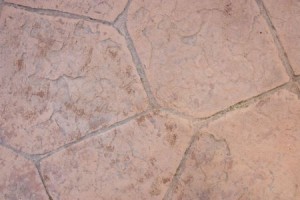
Modern stamped concrete patios are durable, attractive, low maintenance additions to your home’s exterior. After a number of years, however, you might notice that the surface of your patio begins to flake and peel. Eventually, the colors might even fade to dull, blotchy hues. At this point, you’ll want to start thinking about resealing your patio.
Your patio’s sealer constitutes its first line of defense from environmental wear. By resealing your patio, you can prevent future erosion and cracking, keeping it looking its very best well into the future. Before you dive in though, there are a few important things to bear in mind.
When to Reseal
Concrete sealer works best within a fairly narrow temperature window. Ideally, you should be resealing your patio on a day that’s no cooler than 50°F and no warmer than 80°F. You should also wait till you have a few days of consistently dry weather. The last thing you want to do is lock in residual moisture from yesterday’s rainstorm when you apply new sealer.
Before you reseal, you’ll also want to verify that your patio is, in fact, devoid of sealer. To do this, allow a few drops of water to drip onto the surface of the patio. If the water immediately soaks into the concrete, darkening the surface of the patio, then the sealer has worn off. If, however, the water beads, then you still have sealer on your patio. In this case, you might be able to rejuvenate your patio’s finish without resealing.
Prepping the Surface
Before you reseal, you’ll want to make sure that your patio is clean and dry. Use a 3000 PSI pressure washer to clean of dirt, dust, and remaining sealer. If your patio is especially dirty, use a nylon brush and gentle solution of water and dishwashing detergent to scrub away remaining grime. Once your patio is clean, let it sit for at least 24 hours before you apply new sealer. Again, remember that we want to avoid sealing residual moisture into the concrete.
Think Thin
It’s a common misconception that more sealer is always better. In fact, slathering your patio with a thick coat of sealer can actually be counterproductive. Your sealer should act as a thin, porous membrane that allows moisture to escape from the concrete. By applying too much sealer, you can inadvertently lock moisture in. This can cause discoloration and even cracking over time. When you buy your sealer, it will be rated to a specific square footage. Generally speaking, if you have a 200 square foot patio, you should be using a 200 square foot sealer.
Want to learn more about caring for your stamped concrete patio? Give us a call today for a consultation.






